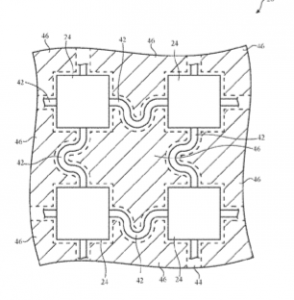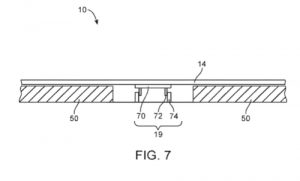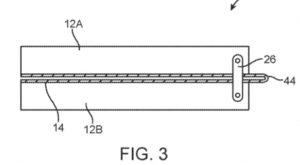“With its OLED innovations, Apple is clearly showing its interest in being a major part of the flexible device display transition that will be occurring in the near future.”
 Apple has increased its expenditures on research and development recently, spending $3.75 billion on R&D during Q4 2018 compared to just less than $3 billion during Q4 2017—a year-over-year increase of $750 million. One area of technology where this investment may pay off will likely be flexible screen technologies. This includes innovations in elastic substrate layers serving as the circuitry for future iPhones and the continuing development of organic light emitting diode (OLED) technologies with flexible characteristics.
Apple has increased its expenditures on research and development recently, spending $3.75 billion on R&D during Q4 2018 compared to just less than $3 billion during Q4 2017—a year-over-year increase of $750 million. One area of technology where this investment may pay off will likely be flexible screen technologies. This includes innovations in elastic substrate layers serving as the circuitry for future iPhones and the continuing development of organic light emitting diode (OLED) technologies with flexible characteristics.
Applications for OLED technology to provide flexible or bendable screens are still in very early stages. OLEDs are made up of a very thin organic compound that can conduct electricity, thereby making a backlight and glass substrate unnecessary. The use of flexible plastic substrates like polyethylene terephthalate (PET) instead of rigid glass allows flexible OLEDS (or FOLEDS) to be bent or rolled. One Apple consumer product that incorporates OLED tech is the Apple Watch, which can use a flat OLED display with a flexible substrate because that device is lightweight and has a thin form factor. However, foldable phones can take greater  advantages of the flexible characteristics of OLEDs by incorporating the OLED with a flexible substrate.
advantages of the flexible characteristics of OLEDs by incorporating the OLED with a flexible substrate.
The use of OLEDs in flexible input-output devices is discussed within U.S. Patent No. 9841548, titled Electronic Devices with Soft Input-Output Components (pictured left). Issued to Apple in December 2017, it discloses an apparatus using an elastomeric substrate layer to form a display for a device with integrated sensors and haptic output. The claimed device would use serpentine signal paths running between electrical components via solder pads that are used to attach components to the substrate layer. The serpentine shapes of the signal paths help to accommodate the stretching of the substrate layer.
 The use of force sensors to detect user inputs via flexible device interfaces is disclosed by Apple’s U.S. Patent No. 10088927, titled Electronic Devices with Flexible Displays (pictured right). It discloses an electronic device that has a flexible display such as an OLED screen that can be deformed in a way noticeable to a user, yet the device remains operational. Such an electronic device would include a flexible substrate and an array of display pixels formed on top of that substrate. Under a portion of the substrate, a force sensor gathers user input by sensing a localized deformation of the substrate. While this patent does not describe a fully foldable smartphone, it does disclose a method in which flexible display technology can be utilized.
The use of force sensors to detect user inputs via flexible device interfaces is disclosed by Apple’s U.S. Patent No. 10088927, titled Electronic Devices with Flexible Displays (pictured right). It discloses an electronic device that has a flexible display such as an OLED screen that can be deformed in a way noticeable to a user, yet the device remains operational. Such an electronic device would include a flexible substrate and an array of display pixels formed on top of that substrate. Under a portion of the substrate, a force sensor gathers user input by sensing a localized deformation of the substrate. While this patent does not describe a fully foldable smartphone, it does disclose a method in which flexible display technology can be utilized.
 The use of flexible displays to provide for devices that can be configured in various positions are described within U.S. Patent No. 10104787, titled Flexible Display Devices (pictured left). The patent protects an electronic device in which first and second housing portions are coupled with a flexible hinge and a flexible display is mounted to both housing portions. The flexible hinge allows one housing portion to rotate relative to another and also allows for a support structure that can be made of a shape memory alloy. The patent discusses flexible display technologies, including OLED, that are capable of allowing a display to be bent in a way that’s not possible with liquid crystal displays that are set under rigid glass.
The use of flexible displays to provide for devices that can be configured in various positions are described within U.S. Patent No. 10104787, titled Flexible Display Devices (pictured left). The patent protects an electronic device in which first and second housing portions are coupled with a flexible hinge and a flexible display is mounted to both housing portions. The flexible hinge allows one housing portion to rotate relative to another and also allows for a support structure that can be made of a shape memory alloy. The patent discusses flexible display technologies, including OLED, that are capable of allowing a display to be bent in a way that’s not possible with liquid crystal displays that are set under rigid glass.
The global market revenue for flexible display shipments increased from $3 billion in 2015 to $8.7 billion in 2018 and by 2022 that figure is expected to grow to $15.6 billion, according to online statistics portal Statista.com. Market intelligence firm Mordor Intelligence recently forecasted that more than 35 percent of smartphone shipments would incorporate OLED screens by the end of 2020. Global technology research firm Technavio firm predicts that the global market for flexible displays will increase at a compound annual growth rate (CAGR) of 47 percent between 2018 and 2022. With its OLED innovations, Apple is clearly showing its interest in being a major part of the flexible device display transition that will be occurring in the near future.
Top Image Source: Deposit Photos
Photography ID: 76639843
Copyright: Kesu01
Patent images: Freepatentsonline

![[IPWatchdog Logo]](https://ipwatchdog.com/wp-content/themes/IPWatchdog%20-%202023/assets/images/temp/logo-small@2x.png)

![[Advertisement]](https://ipwatchdog.com/wp-content/uploads/2024/04/UnitedLex-May-2-2024-sidebar-700x500-1.jpg)
![[Advertisement]](https://ipwatchdog.com/wp-content/uploads/2024/04/Artificial-Intelligence-2024-REPLAY-sidebar-700x500-corrected.jpg)
![[Advertisement]](https://ipwatchdog.com/wp-content/uploads/2024/04/Patent-Litigation-Masters-2024-sidebar-700x500-1.jpg)

![[Advertisement]](https://ipwatchdog.com/wp-content/uploads/2021/12/WEBINAR-336-x-280-px.png)
![[Advertisement]](https://ipwatchdog.com/wp-content/uploads/2021/12/2021-Patent-Practice-on-Demand-recorded-Feb-2021-336-x-280.jpg)
![[Advertisement]](https://ipwatchdog.com/wp-content/uploads/2021/12/Ad-4-The-Invent-Patent-System™.png)






Join the Discussion
2 comments so far.
Anon
January 27, 2019 11:34 amBenny
To your point, how about: “Apple’s lack of creativity here seems to lie not so much in their R&D labs as with their patent attorneys.”
Or maybe there is enough to share around here…?
Benny
January 27, 2019 07:06 amI’m less than impressed with Apple’s US10104787 patent. For example, the following description: “the present invention provides a mechanism for coupling a dual sided, flexible display device and a hinged support mechanism such that moving the hinged support mechanism from an unfolded position to a folded position will result in folding the flexible display in half. The flexible display is coupled along the length of the hinge mechanism. The hinge mechanism is designed such that the bend radius of the display device is great enough to prevent any crease, fold or bend of the viewing area of the display device..” – comes not from Apple’s patent but from a Palm patent filed in 2003. (Anyone remember the Palm Pilot?) Apple’s creativity here seems to lie not so much in their R&D labs as with their patent attorneys.